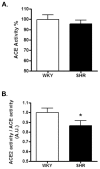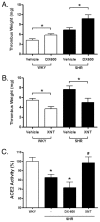ACE2 activation promotes antithrombotic activity
- PMID: 20111697
- PMCID: PMC2811560
- DOI: 10.2119/molmed.2009.00160
ACE2 activation promotes antithrombotic activity
Abstract
The aim of the present study was to test the hypothesis that the activation of the angiotensin-converting enzyme (ACE)2/angiotensin-(1-7)/Mas receptor axis by use of a novel ACE2 activator (XNT) would protect against thrombosis. Thrombi were induced in the vena cava of spontaneously hypertensive rats (SHR) and Wistar Kyoto (WKY) rats, and ACE2 and ACE activity in the thrombus was determined. Real-time thrombus formation was viewed through intravital microscopy of vessels in nude mice. Thrombus weight was 40% greater in the SHR (4.99 +/- 0.39 versus 7.04 +/- 0.66 mg). This weight increase was associated with a 20% decrease in ACE2 activity in the thrombus. In contrast, there were no differences between the WKY and SHR in ACE2 protein and ACE activity in the thrombi. ACE2 inhibition (DX600; 0.1 micromol/L/kg) increased thrombus weight by 30% and XNT treatment (10 mg/kg) resulted in a 30% attenuation of thrombus formation in the SHR. Moreover, XNT reduced platelet attachment to injured vessels, reduced thrombus size, and prolonged the time for complete vessel occlusion in mice. Thus, a decrease in thrombus ACE2 activity is associated with increased thrombus formation in SHR. Furthermore, ACE2 activation attenuates thrombus formation and reduces platelet attachment to vessels. These results suggest that ACE2 could be a novel target for the treatment of thrombogenic diseases.
Figures




References
-
- Willoughby S, Holmes A, Loscalzo J. Platelets and cardiovascular disease. Eur J Cardiovasc Nurs. 2002;1:273–88. - PubMed
-
- Lip GY. Hypertension, platelets, and the endothelium: the “thrombotic paradox” of hypertension (or “Birmingham paradox”) revisited. Hypertension. 2003;41:199–200. - PubMed
-
- Dzau VJ. Theodore Cooper Lecture: Tissue angiotensin and pathobiology of vascular disease: a unifying hypothesis. Hypertension. 2001;37:1047–52. - PubMed
-
- Donoghue M, et al. A novel angiotensin-converting enzyme-related carboxypeptidase (ACE2) converts angiotensin I to angiotensin 1–9. Circ. Res. 2000;87:E1–9. - PubMed
-
- Ferreira AJ, Raizada MK. Genomic and proteomic approaches for targeting of angiotensin-converting enzyme 2 for cardiovascular diseases. Curr Opin Cardiol. 2008;23:364–9. - PubMed
Publication types
MeSH terms
Substances
Grants and funding
LinkOut - more resources
Full Text Sources
Other Literature Sources
Medical
Miscellaneous

